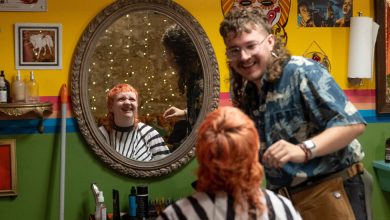In Dapper Croatia, Accessorizing in Style

Croatia is a style-conscious place, and Zagreb, the capital, dresses to impress. Influences from nearby Italy and remnants of its Austro-Hungarian past, along with traditional symbols paired with contemporary design, create a distinctive flair.
Croatia’s claim to haberdashery fame is the cravat, the forerunner to the modern necktie. During the Thirty Years’ War, Croatian cavalry soldiers tied lively scarves around their necks, which women gave to them as a sign of loyalty and love before they went to war. The scarves, tied in a knot, impressed the fastidious Parisians, who adopted the new fashion “à la manière croate” — in the Croatian way. That attention to style has extended to accessories of all types, from hats to umbrellas and jewelry.
At Croata, a stylish, sophisticated shop in the Oktogon Arcade just west of Zagreb’s main square, heritage marries contemporary style in silk scarves, shawls, caftans and ties exclusively made in Croatia. They often feature Croatian symbolism, including Glagolitic script, one of the oldest known Slavic alphabets.
The idea behind the Croata brand, which debuted in 1990, hails from the 1960s, when one of the founders of the company, Marijan Busic, was surprised to learn that the necktie originated in Croatia, and felt that it had deep symbolic meaning for his life and others. “We believe that cravat/necktie is a medium through which we tell the personal stories about the person who wears it,” said Ana Milanovic, retail and tourism coordinator for the brand. To develop the products, six designers collaborate with selected intellectuals, writers and artists, who are responsible for research and background motifs. Each motif has its own story and accompanies the product.
Croata now produces around 70 categories of products in two facilities in the Slavonia region, which has a long tradition of handiwork. Different techniques are used in accessories, including jacquard weaving and screen printing, and the auHRum line incorporates 24-carat gold-laminated silk threads to weave this expensive material for ties, bow ties, pocket squares and cuff links. (Ties range dramatically in price, from 400 to 15,000 kunas, about $61 to $2,297.)
In central Zagreb, Croatian designers and craftsmen cluster on Ilica and Radiceva Streets. In 1999, Vesna Milkovic, the owner and designer of Etno Butik Mara, left her career as a lawyer to chase her dream of promoting Croatia’s ethnic heritage and traditional crafts through original fashion, and her daughter, Marija, followed in her footsteps and will take over the business in a few months. The result is a spot where traditional Croatian art is incorporated into urban fashion and accessories.
Handbags (260 to 780 kunas), backpacks (420 to 580 kunas) and bracelets (180 to 220 kunas) feature motifs from cultural and historical monuments, such as Glagolitic script, early Croatian interlacing patterns, and stylized ornaments of lace from the island of Pag and the town of Lepoglava. Each collection entails research and cooperation with museums and academic institutions, merging the cultural and ethnographic characteristics of regional folk creations with global design trends.
“I descend from a family which has always been engaged in textile handicrafts,” Ms. Milkovic said. “Slavonia, where I was born, has a rich tradition of embroidery and really richly decorated national costumes.” In keeping with these pandemic times, Etno Butik Mara added face masks, which can be personalized with embroidered gold or silver initials in Glagolitic script.
Nada Kobali claimed there was almost no woman in Zagreb who did not own at least one Kobali hat. Her love for hats was born after World War II, when her mother started making them in a Zagreb fur shop; her mother eventually opened her own business in the 1970s. Ms. Kobali took it over and opened Kobali in 1974. She eventually shared all her milliner secrets with her daughter-in-law, Marina Kobali, who took the reins at Kobali after Nada died in 2019.
At Kobali, also in the Oktogon Arcade, the process of making hats with Italian materials has not changed much in the last century. Kobali hats utilize cotton, wool, plush rabbit hair, straw and velour; prices range from 1,600 to 2,000 kunas.
“Every hat is unique and is a true piece of art,” said the younger Ms. Kobali. She added that today, daughters and granddaughters browse current styles and share stories of family members who wore Kobali hats in times past.
“Our family has been in the umbrella business since all the way back to 1912,” said Thomislav Cerovecki, owner of Kisobrani Cerovecki, which has been making umbrellas and parasols for three generations. “We still make umbrellas the way they were made 100 years ago, which means that we use almost no machines, except for the sewing machine and certain small tools. Everything else we do by hand.”
Their handmade Sestine umbrella (680 kunas), which dates to the mid-18th century, is part of the folk costume worn in the Sestine area of Zagreb and is among the city’s most recognizable symbols: a red cotton canopy with multicolored horizontal stripes on the edges, a thick wooden shaft and a naturally crooked chestnut handle.
According to a Zagreb legend, Jankic professed his eternal love to Janica in the rain under a large black umbrella, and when the lovebirds kissed, their umbrella turned red thanks to the strength of their love.
The art of making Sestine umbrellas by the traditional Cerovecki Crafts is a part of the register of protected nonmaterial cultural goods of Croatia. While upholding tradition, the company also innovates. “One day, eight years ago, the young designer Ana Rimac walked into our workshop on Ilica Street, and came to us with the idea to create the first authentic Croatian raincoat,” Mr. Cerovecki said.
The shape of their award-winning raincoat (589 kunas), a collaboration with Ms. Rimac, mimics the distinctive Sestine umbrella. “Thus came to be the Kaplja raincoat, which is made in exactly the same manner in which we usually make umbrellas: the umbrella-like raincoat forms a 360-degree circle.” Umbrellas range mostly from 580 to 750 kunas, and parasols from 550 to 1200 kunas.
Another popular symbol in Zagreb is the bright red licitar heart, glazed gingerbread often decorated with small mirrors, pictures, verses or messages. Taking inspiration from these famed hearts, the goldsmith Mario Nokaj created the Golden Licitar collection in 2009, a tribute to the gingerbread craft from Northern Croatia, now inscribed on the UNESCO Representative List of the Intangible Cultural Heritage of Humanity. You can shop the collection — made with red enamel and sterling silver or 14-carat gold, and sometimes precious stones — at Lapidarium near Zagreb’s main square. Prices range from 80 to 450 kunas for sterling silver; 750 to 3,700 kunas for 14-carat gold; and 1,500 to 22,500 kunas for 14-carat gold with precious stones.
“Gingerbread making is one of the oldest crafts in Zagreb and its surrounding cities,” Mr. Nokaj said. “I wanted to present a piece of Zagreb — let’s say a heritage in one jewelry item.”





